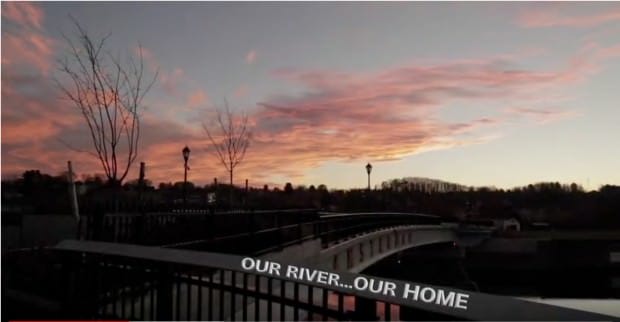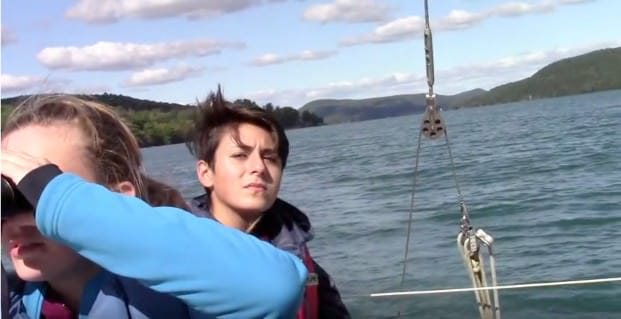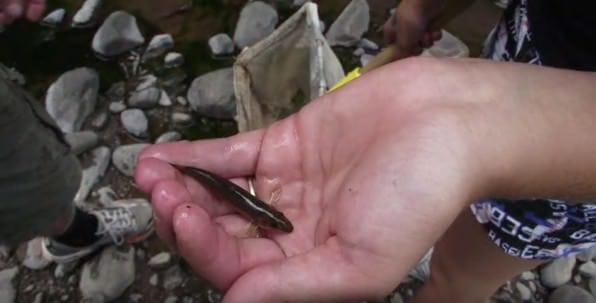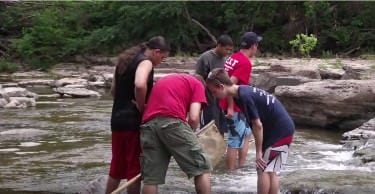
All images are screen shots from “Our River… Our Home,” courtesy of the authors.
It’s Thursday afternoon in Amsterdam, New York, and area high school students are climbing the stairs at the Amsterdam Free Library for their weekly gathering of the Environmental Study Team (EST). Each Thursday from 4 to 6 p.m. this core group of dedicated teens participate in activities that promote the stewardship of their local waters, environment, and community. A partnership program of the New York Folklore Society and the Schoharie River Center (SRC), teens in Amsterdam’s EST program conduct quantitative scientific research about their local waters and engage with the area’s residents and its traditional arts through oral history interviews, media, and folklife documentation.
The Schoharie River Center’s EST is a year-round environmental science-based career and life skills development program of SRC, a nonprofit environmental and cultural organization. Working with youth ages 12 to 18 who live within the Mohawk and Schoharie Watersheds of New York State, the SRC’s EST programs teach youth to assess, record, and document the water quality and health of their communities’ local watersheds. Using EPA-approved testing and assessment procedures (water chemistry analysis, benthic-macroinvertebrate sampling and identification, and bacterial testing) SRC environmental educators work with EST teens in the field (and the streams) to conduct hands-on scientific inquiry-focused research on the ecology of the watershed—its plants, animals, insects, and geology.
As a partnering organization, the New York Folklore Society works with the same youth to teach ethnographic field methods to record the area’s human habitation—its folklore and oral narratives, material culture, occupational traditions, and cultural traditions. Youth in the program work with cameras, digital recorders, and video cameras to document the cultural makeup of the region. In making cultural connections to the region’s waters and ecology, the program encourages the students’ intimate relationships with the environment and their place within this environment and the larger community. SRC and the New York Folklore Society have been engaged in an educational partnership since 2010, working closely with teens in a model of collaborative learning to document both the human and animal habitats.
As students explore watershed ecology they also speak to elders in the community, participate in hands-on folklife experiences, and learn the techniques and skills of oral history and ethnographic field methods. Students explore the “commons” that is the Mohawk/Schoharie Watersheds: They hike its trails, kayak its waters, ski its woods, replenish its riparian zones, and cycle its roadways. They participate in an annual archaeological field school, variously excavating water-powered mill sites on the Schoharie, abandoned Erie Canal locks, community gathering places, and slave and servant quarters of New York’s 18th- and early 19th-century patroons to experience history and learn firsthand about daily foodways and community and agricultural activities. Drawing upon the folklife of the region, they are mentored by community elders to learn dry wall building techniques, historic timber framing methods for barn construction, blacksmithing, and fishing skills such as casting and dry fly making. They interview elders about their play experiences on the Schoharie Creek and their occupational experiences on the Mohawk Barge Canal. Annually students participate in the science of maple syrup production in a timber-framed traditional sugarhouse that several of them built. Throughout, they document their experiences with camera, video, and sometimes audio recording. Drawing upon the skills and methodologies of regional folklife documentation, students are provided instances where people share a body of folklore because of their attachment to place and their shared identity (Jones 1976), and the students both record and participate in those experiences.
The Methodology
The goal of EST is to increase youths’ understanding and knowledge of the emergent environmental issues confronting their communities and provide (through experiential learning) the skills and critical knowledge needed to analyze situations, make informed decisions, and take action to protect and improve the quality of their local environment (McKeeby, Jones, Keville, and McKeeby 2011). Youth come to the program from a variety of avenues: self, friend, or family referral (60 percent); referred by a school counselor, probation officer, or a community service provider (40 percent). Participation is voluntary, and most youth choose to participate for an average of four to five years, through middle and high school—years that are often times of turbulence and transformation for many young people. The EST program is intended to influence youth at many levels. Through focusing on their strengths, their natural curiosity and interest in the world, and their developmental needs, the program is able to establish areas of mastery, healthy relationships, and positive identity in the students’ lives. For troubled and at-risk youth, the EST program provides the physical and the psychological space to explore their world (the natural environment and community) through an objective lens based on the scientific methods of observation, data collection, and analysis. EST youth explore and assess their environment while working in teams with other youth and trained adult environmental educators, field biologists, archeologists, and community scholars.
Youth in EST meet weekly, with each of the regions’ five chapters conducting stewardship over their local waters. The Amsterdam Environmental Study Team meets in an after-school setting in the local library. In 2017, through grants from the New York State Council on the Arts and the Community Foundation of the Capital Region, the EST program began to work with staff of the New York Folklore Society and Youth FX, an Albany-based video production program that engages youth in making media productions. Beginning in 2017, the EST team worked with Youth FX to learn techniques of video production and editing. As an object of study, they focused upon the newly constructed pedestrian bridge recently built to link two Amsterdam neighborhoods previously separated by the Mohawk River. The youth of the Amsterdam EST program had already experienced the difficulties in accessing the Mohawk River as the city, and its highway and railroad, provided barriers to direct access to the waterfront. Because of this, they were interested in documenting community perceptions of the Mohawk River and the impact upon these perceptions by the increased accessibility accorded by a pedestrian bridge that was newly completed. This pedestrian bridge linked two communities in Amsterdam and provided a way to traverse from highly industrialized North Amsterdam to the historic neighborhood of Port Jackson. The team’s short-term exposure to Youth FX’s film program resulted in a five-minute film shot and edited by the students.
Buoyed by this initial experience, the Amsterdam EST teens immediately began planning their next video documentary in a more direct merging of their hands-on scientific inquiry and video documentation. As with several communities in the northeastern U.S., Amsterdam is a 20th-century industrial city with an aging infrastructure. Its wastewater treatment system is dependent upon early 20th-century technology that includes aging sewage pipes as well as an outdated combined sewer/storm water outflow system (CSD) of handling rainwater. For decades, this aging sewer system of the city has been regularly malfunctioning, dumping raw sewage into the Mohawk River by way of the North Chuctanunda Creek. This has been compounded with each heavy rain as the combined stormwater/sewage drainage system that is a typical response mechanism to drainage in many cities is engineered to get rid of excess water by dumping it into our nation’s waterways. While Amsterdam is not alone in its need to mitigate sewage leaks into major waterways, the city experienced ongoing problems in 2016 and 2017, probably as a result of climate change and a documented increase in the frequency of high rain events in this part of New York State. The frequent sewage discharges heightened public awareness of the problem.
After their initial success with shooting and editing My River, My Home, the teens of the Amsterdam Environmental Study Team program wanted to shoot and script their own documentary about the effects of outdated wastewater treatments systems on the health of the Mohawk watershed. Armed with cameras, notebooks, and video equipment, the team set out to study the problem and determine the extent of public awareness. Adult leaders conceived of their role as catalysts and mediators, helping students to explore their “place” through the memories, experiences, and words of Amsterdam’s narrators and tradition bearers. Drawing upon previous folklore fieldwork, the program introduced students to people who might provide points of view that they might not get from the governmental structures or civic leaders who are most often the spokespeople for communities. Students interviewed community members such as a lock tender on the Mohawk Barge Canal; the Haudenosaunee Mohawk spiritual leader Tom Porter, who had founded a new Mohawk community on the shores of the Mohawk River; key high school teachers; local historians; and community scholars. The students spent an afternoon with the engineering staff of the New York State Canal Corporation who are directly responsible for the canal system’s maintenance. On several occasions, they interviewed the many casual boaters and yachtsmen who have taken advantage of Amsterdam’s marina and dock space. They contacted the mayor and public works personnel. They conducted a survey, using psychometric indicators, to ascertain whether the new pedestrian bridge has affected feelings of “place attachment” with Amsterdam’s residents who are increasingly finding the bridge to be a pleasant recreational space. These experiences were added to the ethnographic documentation collected in 2016 and early 2017. Folklore and education professionals provided models and visionary leadership for the effective engagement of students with tradition bearers and community scholars.

Merging Cultural Documentation and Environmental Education
The experiential nature of environmental education has been shown to be effective in the development of social skills, individual agency, and competence (Chawla 2006). As youth encounter their physical and cultural environments, they learn that they can think critically about their communities and their roles as agents of change within their community (Schusler et al. 2009). Youth engaged in experiential learning through the EST program frequently enter the program with a hands-off attitude towards scientific inquiry, having learned the scientific methods taught in school but being told they will have an opportunity for direct participation only when they reach more advanced studies. In EST, microscopes are provided to each individual to view biological samples and one middle schooler expressed disbelief that she would actually get to “touch” the microscope. Another student who spent five years in the EST program related that her field biology class in college was repeating activities in which she had actively engaged as a 15-year-old EST member.
The process of experiential learning begins with students at only a rudimentary knowledge of field biology but with a genuine curiosity and eagerness to learn more. The EST model is joyful, allowing them to move from question to question to arrive at the answer. In the meantime, they are fully enjoying the sensory experience of being outdoors and in the moment of discovery and knowledge formation.
The geographer Yi Fu Tuan has provided an important framework for effective education in the “out of doors” through his theorizing about place and the role of place in culture. In his work on “senses of place,” Tuan observes that places gain meaning through the activity that we partake when in that locale, through the sharing of experience with other individuals, and the memories of the experiences in a place that bind us to that place in the future. Environmental psychologists have further examined Tuan’s concept and have made the distinctions between place “meaning”—the importance that individuals ascribe to a place—and place “attachment,” the degree to which individuals forge their identity through their relationship with place. Place-based educators have shown that youth shape their affordances—their “possibilities for action”—through participating in activities within their communities and in the social interactions that occur within community settings. Delia and Krasny point out that these opportunities lead to the development of youth assets such as caring, contribution, and competence while incorporating critical thinking and awareness (Delia, Jesse and Krasny, Marianne 2018). Using students’ personal senses of place and their attachment to a locale through the EST program strengthens their educational experience. In their focus upon informed action, EST youth demonstrate that they can use their perceptual senses to draw conclusions. In acting upon their concerns, their connections to place are strengthened.
Educator David Gruenewald suggests that the study of “place” foregrounds “a narrative of local and regional politics that are attuned to the particularities of where people actually live.” He calls for educational approaches that are concerned with context and those that are predicated upon the value of learning from and nurturing specific places, communities, and regions (Gruenewald 2003, 3). Gruenewald challenges the educator to move beyond current place-based (and celebratory) education models to link ecology to critical themes such as urbanization and the homogenization of culture. He advocates for a framework of “eco-justice,” which understands the relationships between ecological and cultural systems, addresses environmental racism, revitalizes the non-commodified traditions of different racial and ethnic groups and communities, and supports reconceiving and adapting our lifestyles in ways that will not jeopardize the environment for future generations (Gruenewald 2003). In using the lens of eco-justice, one recognizes the responsibility to conserve and restore our shared environments for future generations. Gruenewald calls attention to the skills and talents of ethnographers in his description of a place-based education and ecojustice model that relates directly to student experiences of the world and improves the quality of life for peple and communities in all locales—urban, suburban, and rural. His is a pedagogy of place that evaluates the appropriateness of our relationships to each other and to our socio-ecological places. He calls for students to re-inhabit their places—to pursue social action that improves the social and ecological life of places (Gruenewald 2003).

The Process at Work
With the established EST model of youth-driven inquiry, the Amsterdam cultural documentation and videography project was similarly driven by youth. Through a grant from the New York State Council on the Arts, inexpensive but high-quality video equipment was purchased to create two documentation kits that would require the students to work in teams of at least three for the actual recording, with one student serving as the interviewer, one monitoring the sound recording, and one monitoring the video camera. When there were additional students, SLR cameras were provided so no one was left without a role. With two documentation kits, students could actually accomplish a two-angle shoot or record additional footage while one team was engaged in an interview.
Throughout, students were in control of the situation. With guidance from the adult leaders (folklorist Ellen McHale and environmental educators John McKeeby and Scott Hadam), students discussed the water quality problems that they would like to highlight and individuals whom they thought would help them attain the knowledge that was required. Students made lists of the individuals in their community whom they felt it was important to reach. They made the appointments and set up the interview situations, requiring persistence and direct interactions with unknown adults in their community. As the project continued and the students gained knowledge of the issues, their lists of interview subjects expanded. Not surprisingly, they began the project by interviewing their favorite teachers at the high school. An interview with a high school English teacher revealed that not only had he grown up on the Mohawk River, but his father was a foreman in charge of a portion of the canal system from Lake Champlain to Utica. A subsequent interview pointed students to an engineer within the Canal Corporation, and so on. As students followed these leads they also found that the individuals inhabiting their home and school networks could connect them to the wider community in ways that they had not envisioned. Information sources became multidimensional. As their knowledge deepened, so too did their perspectives. An interview with the Amsterdam Water Works supervisor led them to the city engineer, who shared his perspectives on the overwhelming task of tackling the ancient water infrastructure. Empathy began to replace anger, and students’ questions changed from “how could they?” to “how can WE make a difference?”
The project’s documentary style was organic as the students conducted the research. They developed questions they wished to ask and only then asked adult leaders for approval or input. As the project’s headquarters was a public library, research materials were easily obtained and accessed. As students interviewed the adults and asked well-phrased questions, those in the interviewing hot seat often physically changed their manners throughout the interview. As the students shared their own knowledge from prior conversations, or from their own scientific studies on the river, adult experts’ answers became more informative. In several instances, there was a perceptual shift when those being interviewed realized that they were not in the company of an ill-informed student population. Conversations became livelier as students offered their knowledge and illustrated that they were backing their questions with well-done research.
Now in its second year, the Amsterdam Cultural Documentation project is in its final stages. As students have matured developmentally, they have matured in their abilities to empathize with others. They have also matured in their relationships with each other as they work together as a well-functioning team. A watershed moment occurred in this final year. Combing through hours of video footage, they sought the “adult” words that would express what they themselves knew. As they frantically named individuals and quoted statements, Youth FX leader Bhawin Suchak asked them to stop a minute and to formulate their own statements. The students realized that they themselves held the knowledge. That was a particularly empowering moment as student became expert. They had found their voice.
The connections that EST makes—between community and ecosystem, traditional folklife and landscape, culture and environment—provide an opportunity and a pathway for young people to forge an ethical relationship to land and community. Of primary importance to the Amsterdam EST students is the environmental degradation of the waterways and their growing feelings of stewardship for their place. Following Gruenewald, the students are re-inhabiting their community, learning to live well—socially and ecologically—in their “disrupted and injured” place. They are challenging each other, and the adults of the community, to “read the texts of their own lives and to ask what needs to be transformed and what needs to be conserved.” Through folklife and cultural documentation of their community, Amsterdam EST youth are drawing upon mentoring and intergenerational relationships with the adults in their lives. This in an act of ecojustice (Gruenewald 2003). In their pursuit of ecological awareness and literacy, the students have augmented their sense of place and defined their roles as active, informed, and engaged community members able to make a difference.

The Schoharie River Center’s Environmental Study Team Program is an award-winning youth development program that is cost effective, successful, and easily replicated. The Schoharie River Center is available to any organization, school, or group interested in initiating an EST program in their community.
Ellen McHale holds a PhD in Folklore and Folklife from the University of Pennsylvania. Since 1999, she has served as the Executive Director of the New York Folklore Society, a statewide organization dedicated to the study, preservation, and promotion of New York’s traditional arts and culture. The professional collaboration between the New York Folklore Society and the Schoharie River Center, upon which this work is based, began in 2011 and continues to the present.
John McKeeby is Executive Director of the Schoharie River Center. He holds a Master’s in Developmental Psychology (Drexel University) and a post-Master’s Certificate in Structural Family Therapy from the Family Therapy and Training Center of the University of Pennsylvania’s School of Education. A co-founder (with Ellen McHale), of the Schoharie River Center, the EST program has twice been awarded the Seaworld/Busch Garden’s Environmental Excellence Award (2008 and 2011) and was awarded the New York State Department of Conservation’s Environmental Excellence Award in 2013.
URLs
My River, My Home film: https://www.youtube.com/watch?v=fneT8uyC_dg
Works Cited
Chawla, Louise. 2006. Learning to Love the Natural World Enough to Protect It. Barn. 2: 57-78.
—. 2008. Participation and the Ecology of Environmental Awareness and Action. In Participation and Learning: Perspectives on Education and the Environment, Health and Sustainability, eds. Alan Reid, Bjarne Bruun Jensen, Jutta Nikel, and Venka Simovska. The Netherlands: Springer, 98-110.
Christensen, Laird. 2003. Writing the Watershed. In Teaching in the Field: Working with Students in the Outdoor Classroom, ed. Hal Crimmel. Salt Lake City: University of Utah Press, 124-36.
Delia, Jesse and Marianne Krasny. 2018. Cultivating Positive Youth Development, Critical Consciousness, and Authentic Care in Urban Environmental Education. Frontiers in Psychology. 8.2340: 1-14.
Gruenewald, David. 2003. The Best of Both Worlds: A Critical Pedagogy of Place. Educational Researcher. 14.3: 308-24.
Johnson, Dale. 2002. Camp Woodland: Progressive Education and Folklore in the Catskill Mountains of New York. Voices: The Journal of New York Folklore. 28.1: 6-12.
Jones, Suzi. 1976. Regionalization: A Rhetorical Strategy. Journal of the Folklore Institute. 13.1: 105-20.
McKeeby, John, Jessica M. Jones, Mary Rachael Keville, and Zach McKeeby. 2011. The Schoharie River Center’s Environmental Study Team: A Community Based Watershed Education Program. Proceedings of the 2011 Mohawk Watershed Symposium, 34-6. Accessed July 5, 2018, https://www.researchgate.net/publication /303785503_Proceedings_from_the_2011_Mohawk_Watershed_Symposium.
Schusler, Tania M., Marianne E. Krasny, Scott J. Peters, and Daniel J. Decker. 2009. Developing Citizens and Communities Through Youth Environmental Action. Environmental Education Research. 15.1: 111-27.
Semken, Steven and Carol Butler Freeman. 2008. Sense of Place in the Practice and Assessment of Place-Based Science Teaching. Science Education. 92.6: 1042-57.

